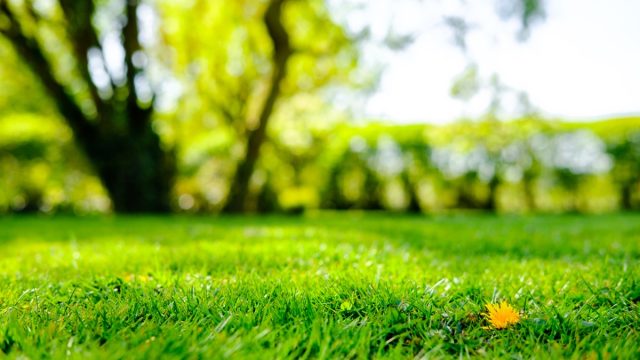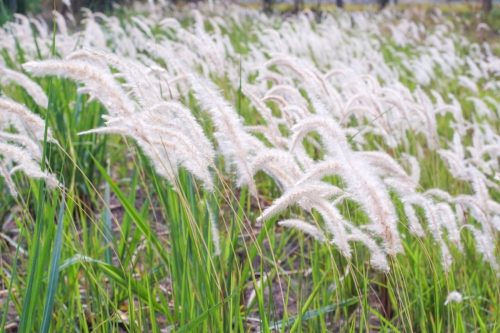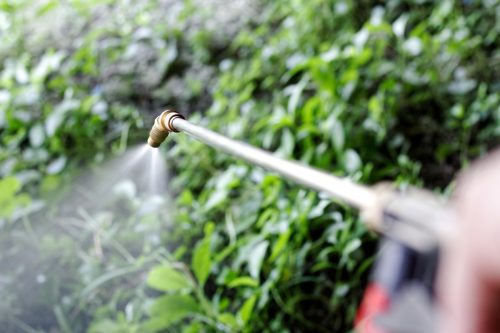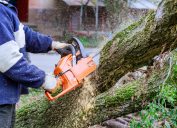If You Have This Grass in Your Yard, Kill It Immediately, Experts Say
Certain varieties are sold as decorations, even though they're dangerous.

Even if you're not a dedicated gardener, you might at least take pride in the state of your lawn. Keeping it tidy makes your yard nice to look at, and a healthy lawn can help with flood control and prevent erosion, according to the University of Minnesota Extension. You can also raise the property value of your home as a whole by increasing curb appeal, especially if your yard is preened and pruned regularly. But if you have one kind of grass growing outside of your home, it could actually do real harm. Read on to find out why experts say you should kill this grass immediately.
READ THIS NEXT: If You Have This Tree in Your Yard, Kill It and Cut It Down, Experts Warn.
Invasive plants cause serious damage.

At first glance, it's difficult to determine whether a plant is friend or foe. Botanists and scientists are often issuing warnings about dangerous plants, which are generally of the invasive variety. To be classified as "invasive," the plant must be both non-native to the U.S. and "likely to cause economic or environmental harm or harm to human health," the U.S. Forest Service states.
Wild parsnip, for example, is not native to the U.S., but it's now commonly found in 45 states. According to the New York Invasive Species Information website, this plant poses a unique threat, as it has a compound in its sap that can cause chemical burns on the skin when mixed with sunlight.
Garlic mustard, on the other hand, won't leave rashes or blisters on your skin—and some people even eat it—but it is a threat to surrounding wildlife and the biodiversity of native ecosystems in the U.S. This plant is able to spread without restraint, as animals don't nibble on it, and it kills surrounding fungi by releasing chemicals through its roots.
Now, experts have warned about an invasive grass that appears to be expanding its influence.
This grass is actually a noxious weed.

One of these difficult invasive plants is cogongrass, which is native to East Africa and Southeastern Asia, according to the U.S. Department of Agriculture (USDA) National Invasive Species Information Center. It has been regulated as a Federal Noxious Weed under the Plant Protection Act, due to its ability to crowd out other plants.
Cogongrass first arrived in Louisiana in 1912 by accident, the USDA states, but it was then introduced on purpose in Florida in the 1930s. According to the University of Florida, the grass was intended to be used as packing material and as a forage crop, providing food for grazing animals. Unfortunately, cogongrass proved to be a poor choice, as livestock don't eat it or have trouble digesting it when they do, the Alabama Department of Agriculture explains.
In addition to being a poor choice for feed, mature cogongrass blades die, but are still attached to the plant. This increases its flammability—and as the grass burns very hot, and can put you and your property in danger, per the University of Florida.
RELATED: For more up-to-date information, sign up for our daily newsletter.
Cogongrass appears to be spreading.

Similar to other invasive species, cogongrass poses a threat as it spreads rapidly. Wind, people, and vehicles often carry and disperse cogongrass seeds, but its ability to spread is also thanks to its rhizomes. These are essentially stems that grow underground, the USDA Southern Research Station explains, and they're sharp enough to puncture other plants' roots, effectively excluding them. Even after a fire, cogongrass "quickly recovers," and infiltrates areas where other plants burned, per the University of Florida.
The invasive grass is prevalent throughout the southeast portion of the U.S., but it was just spotted in Idaho in May, High Country News reported. Cogongrass was discovered in Boise on the roadside—an area where it thrives—and when reporting the sighting to Idaho state experts, botanist Ann DeBolt called it "extremely alarming."
Officials want you to be on the lookout for cogongrass, which has a few distinctive features depending on the time of year. The grass likes to grow in circular formations where it can get sunlight or partial shade, according to the Alabama Department of Agriculture. When spring arrives, the seed heads also appear "fluffy" and white in color. Cogongrass leaves are sharp on the edges and green in color, but they can also be red. In this case, the plant is known as Red Baron grass or Japanese blood grass.
You'll need to get rid of this grass if it's in your yard—but it's easier said than done.

Red Baron grass and Japanese blood grass are often available for sale as decorative plantings, meaning you could inadvertently introduce this species to your yard. Officials urge you not to purchase either of these varieties, but if they ended up among your shrubs, you'll need to take steps to clear them out.
Getting rid of cogongrass can be tricky, and you shouldn't try to pull the plants yourself (thanks to those sharp leaves). Herbicides like glyphosate are used to eradicate this plant, and the Alabama Department of Agriculture warns that you'll likely need to seek professional assistance to help form a treatment plan and apply the proper chemicals.
The plant is rapidly spreading, as evidenced by its arrival in Idaho, which is why experts stress the need to report any sightings—whether it's at your home or elsewhere. You can also report cogongrass using EDDMapS, which helps experts track where cogongrass has planted its roots.





















